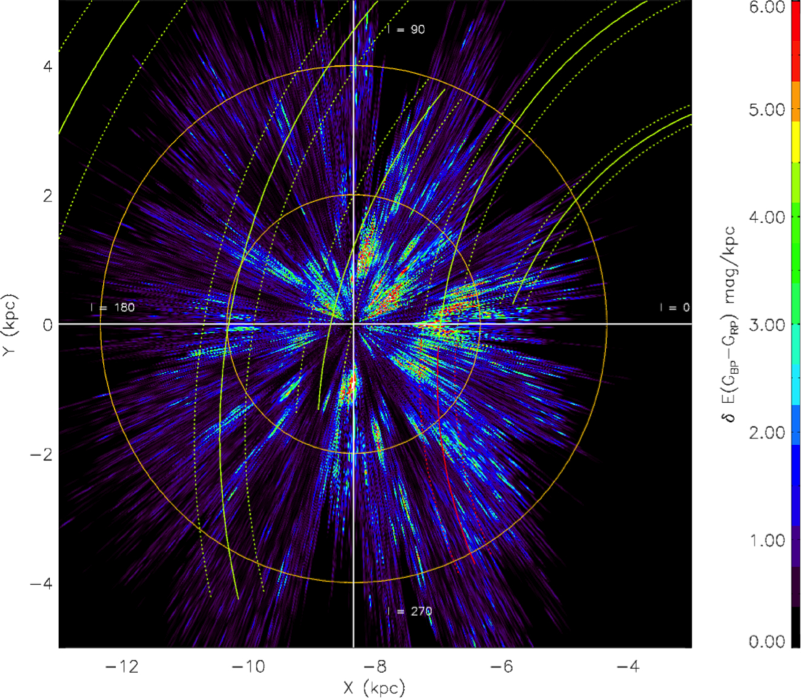中国西南天文研究所研究团组精确描绘银盘三维星际尘埃分布
Three-dimensional mapping of the interstellar dust in the Galactic disk
近日,云南大学中国西南天文研究所陈丙秋副教授和刘晓为教授利用机器学习的方法测量了银河系低银纬区域超过5600万颗恒星的色余值,并精确地描绘了银盘4 – 6 kpc内三维尘埃消光分布。
在银河系和河外星系的恒星之间有着广袤的空间。在恒星与恒星之间这广袤的空间中存在一些微小的固体颗粒,我们称之为星际尘埃。星际尘埃在星系演化、恒星与行星系统的形成, 乃至生命的起源中都起着重要作用。此外,星际尘埃会吸收和散射可见光与近红外波段的光线,产生消光与红化效应,所以依赖这些观测的科学研究必须考虑去除星际尘埃的影响。银河系的星际尘埃主要集中在银盘也就是低银纬方向,使得处于银盘的恒星受到的星际消光与红化的影响尤其严重。天文学家通过制定精确的银河系三维尘埃消光分布图,以准确地改正观测天体的消光与红化效应。
要获取精确的银盘三维尘埃分布图,需要精确的距离信息,欧洲空间局盖亚任务小组发布的盖亚天文卫星(GAIA)第二批数据(GAIA DR2)提供了全天超过十亿颗恒星精确的三波段测光与距离信息,为我们绘制银盘三维消光图提供了高质量的数据。然而要利用传统的方法对数千万颗恒星逐一地计算其消光与色余值太耗费时间。云南大学中国西南天文研究所团组收集了银盘中超过5600万颗恒星的Gaia DR2, 2MASS和WISE多波段测光数据,采用LAMOST、SEGUE和APOGEE的光谱数据作为训练样本,利用随机森林回归的机器学习方法得到了所有恒星的多波段色余值。该方法与传统的方法相比,得到的结果精度类似,但是花费时间大大减少。结合Gaia DR2提供的精确的恒星距离信息与随机森林回归方法得到的恒星色余信息,研究团组绘制了国际上首张完整覆盖银盘的高精度三维尘埃分布图。基于该尘埃分布图,研究团组还测量了银河系尘埃盘的翘曲结构,探索了银河系旋臂结构。该研究工作已在国际专业学术期刊《皇家天文学月刊》(Monthly Notices of the Royal Astronomical Society)发表(文章链接:https://academic.oup.com/mnras/article/483/4/4277/5237718)。

图. 银道面(银纬小于0.1度)上星际尘埃分布。不同的颜色代表了星际红化的强弱。太阳(坐标为X = -8.34, Y = 0)位于图的中心,两个棕色的圆分别标示了离太阳2,4个kpc距离的区域。图中黄色和红色的实线和虚线标示了银河系旋臂的大致区域。Distribution of local dust in the Galactic plane (|b| < 0.1°). The Sun, assumed to be at 8.34 kpc from the Galactic centre, is located at the centre of the plot. Brown circles are placed every 2 kpc from the Sun. The directions of l = 0°, 90°, 180°, and 270° are also marked in the plot. The yellow solid and dashed curved lines denote the centre and ±1 σ widths of spiral arm models of, from left to right, the Outer, Perseus, Local, Sagittarius, and Scutum arms, taken from Reid et al. (2014). The red lines are the same model of Sagittarius but have Galactocentric azimuth β extending from −2° to −30°.

The interstellar dust extinction poses a serious challenge for the study of the structure, formation, and evolution of our Galaxy, especially for the low Galactic latitude disc regions. For any stellar study near the Galactic plane, one needs to correct for the effects of dust extinction and reddening to interpret the observations properly. Three-dimensional (3D) extinction maps can be used to accurately correct these effects.
To build accurate 3D extinction maps, distance is a key parameter to build a 3D extinction map. The second Gaia Data Release (Gaia DR2) contains parallax estimates for over one billion stars. The Gaia DR2 also includes high-quality photometry in three bands. The robust distance estimates and the precise photometry of Gaia DR2 provide us a great opportunity to construct high-quality 3D extinction map of the Galactic disc. We have combined the Gaia optical with the 2MASS and WISE IR photometry, and obtain robust estimates of colour excess in several colours for over 56 million stars in the Galactic disc (|b| < 10°). We adopt the Random Forest regression, a machine-learning algorithm, to derive the values of colour excess, using a training data set constructed from the large-scale spectroscopic surveys, Large Sky Area Multi-Object Fibre Spectroscopic Telescope, Sloan Extension for Galactic Understanding and Exploration, and Apache Point Observatory Galactic Evolution Experiment. Compared to the traditional SED fitting or Bayesian approaches, this machine-learning algorithm works much faster to provide results of similar accuracies. The results are then used to construct 3D colour excess maps of the Galactic disc. We present new three-dimensional (3D) interstellar dust reddening maps of the Galactic plane in three colours. The maps covers over 7000 deg2 of the Galactic plane for Galactic longitude 0° < l < 360° and latitude |b| < 10°.The results reveal the large-scale dust distribution in the Galactic disc. The Galactic dust disc is clearly warped and show complex structures possibly spatially associated with the Sagittarius, Local, and Perseus arms. The paper has been published in the Monthly Notices of the Royal Astronomical Society (article link: https://academic.oup.com/mnras/article/483/4/4277/5237718).
